Comprehensive Analysis: Inclusive Teaching and Learning Approaches
VerifiedAdded on 2023/04/23
|10
|2468
|235
Report
AI Summary
This report provides a comprehensive overview of inclusive teaching and learning approaches in education and training. It delves into the role of inclusive methods in fostering equal opportunities and participation for all learners, emphasizing the importance of understanding diverse learning styles and needs. The report discusses the strengths and limitations of various teaching methods, such as PowerPoint presentations, group work, and demonstrations, in relation to meeting individual learner needs. It highlights the significance of creating an inclusive learning environment, considering factors like physical accessibility and classroom layout. Furthermore, the report examines the importance of developing functional skills and wider skills, as well as strategies for engaging and motivating learners. It also outlines the process of establishing ground rules with learners to promote a positive and productive learning environment. The report provides valuable insights for educators seeking to create effective and inclusive learning experiences.
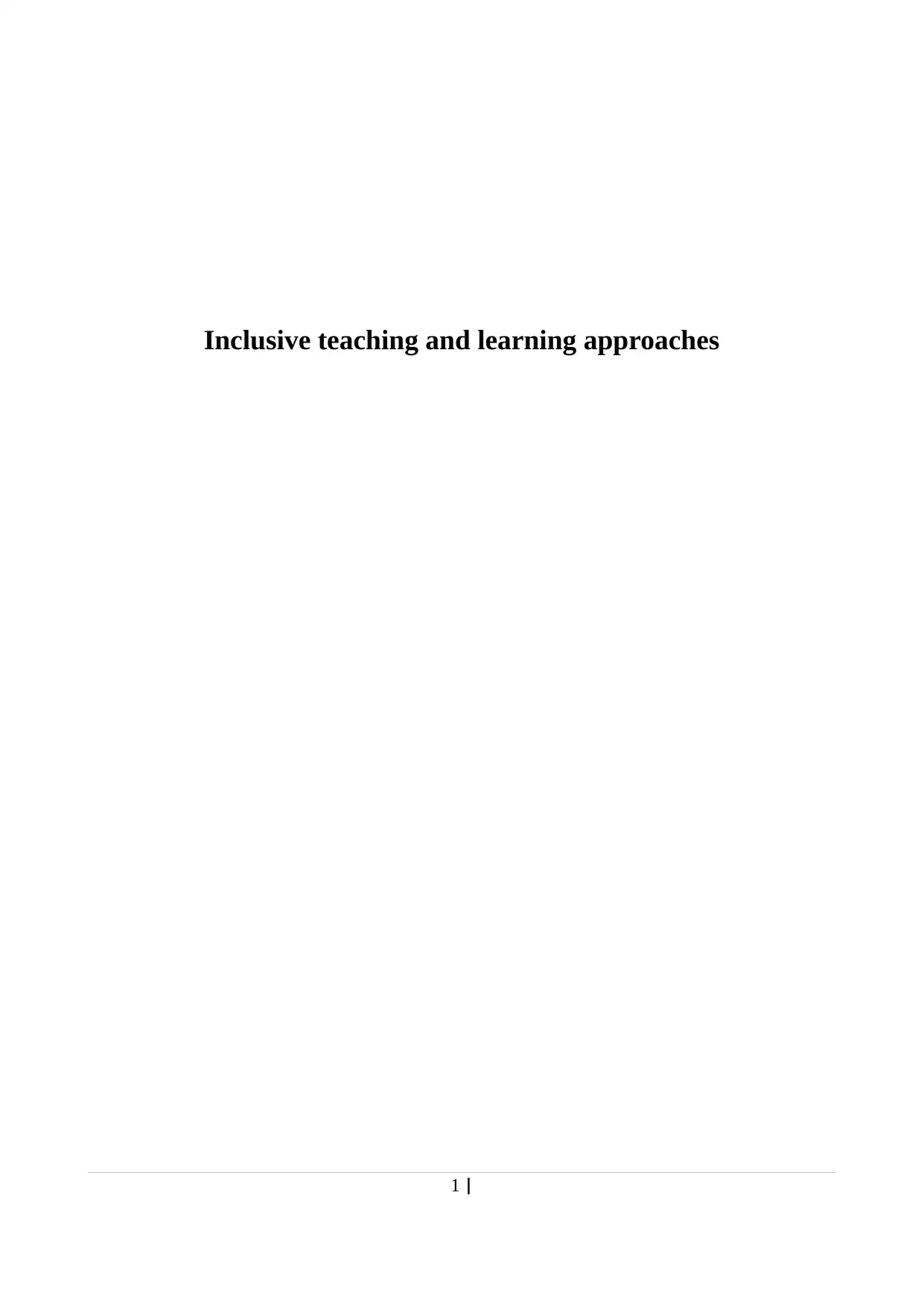
Inclusive teaching and learning approaches
1 |
1 |
Paraphrase This Document
Need a fresh take? Get an instant paraphrase of this document with our AI Paraphraser
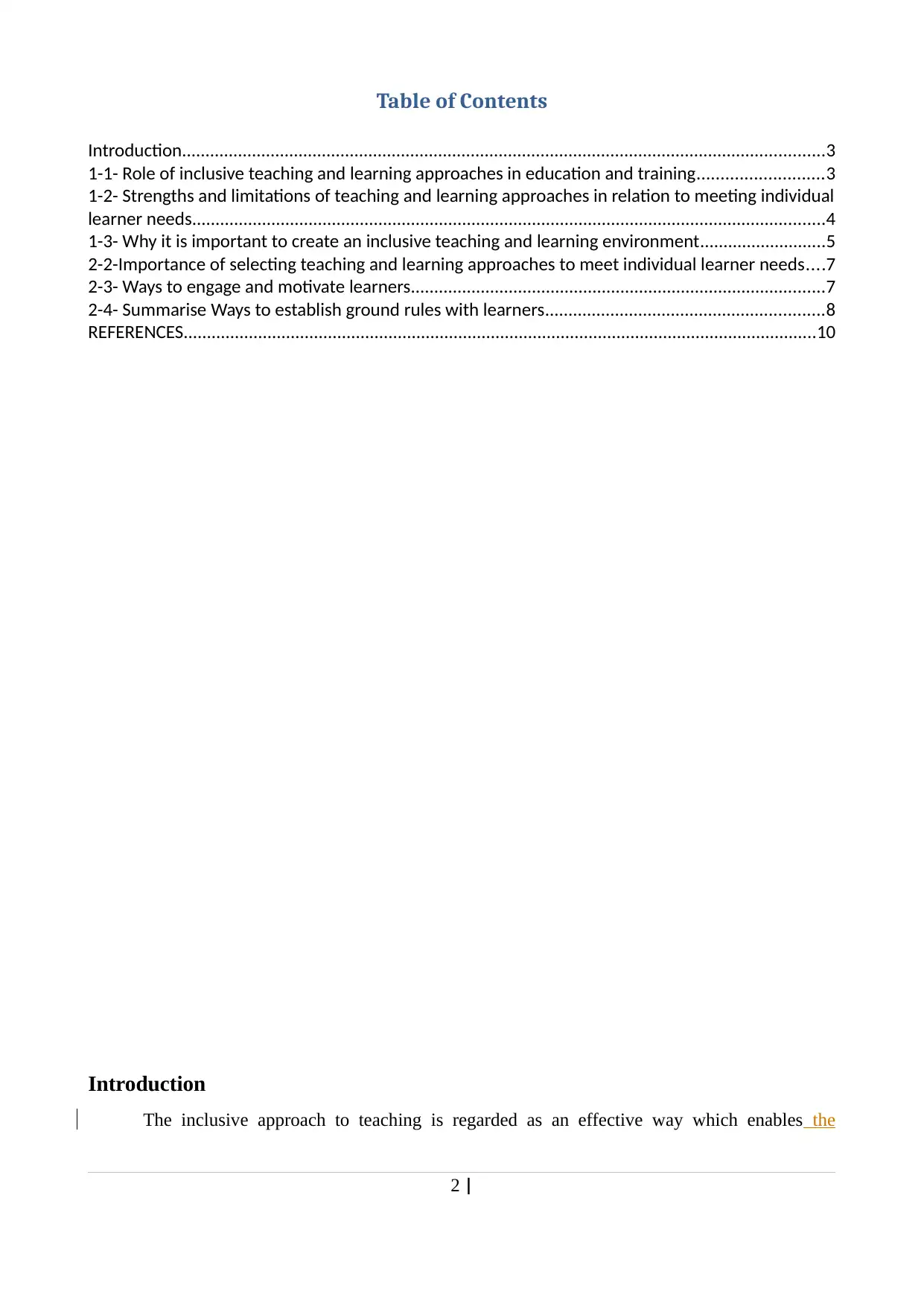
Table of Contents
Introduction..........................................................................................................................................3
1-1- Role of inclusive teaching and learning approaches in education and training...........................3
1-2- Strengths and limitations of teaching and learning approaches in relation to meeting individual
learner needs........................................................................................................................................4
1-3- Why it is important to create an inclusive teaching and learning environment...........................5
2-2-Importance of selecting teaching and learning approaches to meet individual learner needs....7
2-3- Ways to engage and motivate learners.........................................................................................7
2-4- Summarise Ways to establish ground rules with learners............................................................8
REFERENCES........................................................................................................................................10
Introduction
The inclusive approach to teaching is regarded as an effective way which enables the
2 |
Introduction..........................................................................................................................................3
1-1- Role of inclusive teaching and learning approaches in education and training...........................3
1-2- Strengths and limitations of teaching and learning approaches in relation to meeting individual
learner needs........................................................................................................................................4
1-3- Why it is important to create an inclusive teaching and learning environment...........................5
2-2-Importance of selecting teaching and learning approaches to meet individual learner needs....7
2-3- Ways to engage and motivate learners.........................................................................................7
2-4- Summarise Ways to establish ground rules with learners............................................................8
REFERENCES........................................................................................................................................10
Introduction
The inclusive approach to teaching is regarded as an effective way which enables the
2 |
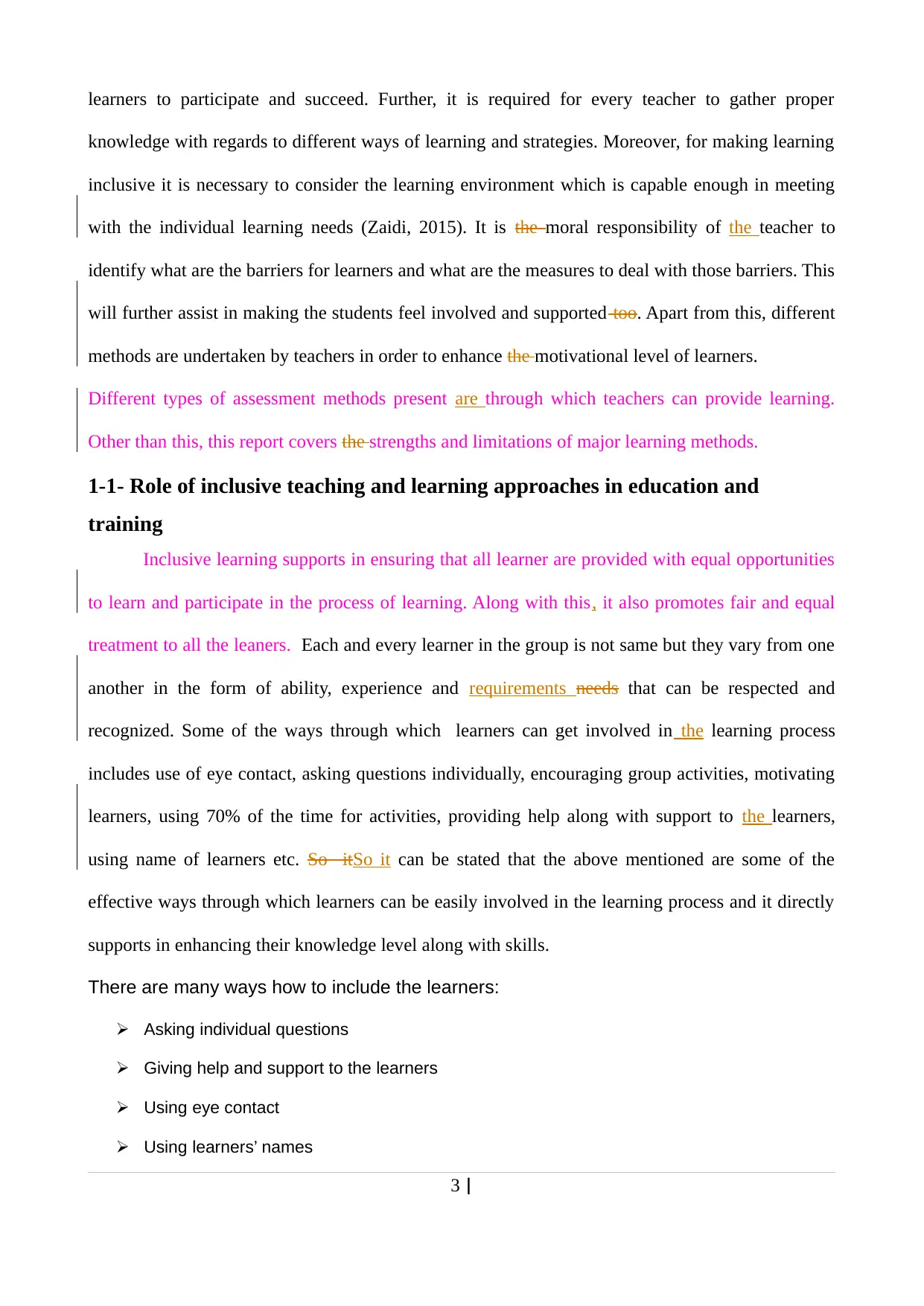
learners to participate and succeed. Further, it is required for every teacher to gather proper
knowledge with regards to different ways of learning and strategies. Moreover, for making learning
inclusive it is necessary to consider the learning environment which is capable enough in meeting
with the individual learning needs (Zaidi, 2015). It is the moral responsibility of the teacher to
identify what are the barriers for learners and what are the measures to deal with those barriers. This
will further assist in making the students feel involved and supported too. Apart from this, different
methods are undertaken by teachers in order to enhance the motivational level of learners.
Different types of assessment methods present are through which teachers can provide learning.
Other than this, this report covers the strengths and limitations of major learning methods.
1-1- Role of inclusive teaching and learning approaches in education and
training
Inclusive learning supports in ensuring that all learner are provided with equal opportunities
to learn and participate in the process of learning. Along with this, it also promotes fair and equal
treatment to all the leaners. Each and every learner in the group is not same but they vary from one
another in the form of ability, experience and requirements needs that can be respected and
recognized. Some of the ways through which learners can get involved in the learning process
includes use of eye contact, asking questions individually, encouraging group activities, motivating
learners, using 70% of the time for activities, providing help along with support to the learners,
using name of learners etc. So itSo it can be stated that the above mentioned are some of the
effective ways through which learners can be easily involved in the learning process and it directly
supports in enhancing their knowledge level along with skills.
There are many ways how to include the learners:
Asking individual questions
Giving help and support to the learners
Using eye contact
Using learners’ names
3 |
knowledge with regards to different ways of learning and strategies. Moreover, for making learning
inclusive it is necessary to consider the learning environment which is capable enough in meeting
with the individual learning needs (Zaidi, 2015). It is the moral responsibility of the teacher to
identify what are the barriers for learners and what are the measures to deal with those barriers. This
will further assist in making the students feel involved and supported too. Apart from this, different
methods are undertaken by teachers in order to enhance the motivational level of learners.
Different types of assessment methods present are through which teachers can provide learning.
Other than this, this report covers the strengths and limitations of major learning methods.
1-1- Role of inclusive teaching and learning approaches in education and
training
Inclusive learning supports in ensuring that all learner are provided with equal opportunities
to learn and participate in the process of learning. Along with this, it also promotes fair and equal
treatment to all the leaners. Each and every learner in the group is not same but they vary from one
another in the form of ability, experience and requirements needs that can be respected and
recognized. Some of the ways through which learners can get involved in the learning process
includes use of eye contact, asking questions individually, encouraging group activities, motivating
learners, using 70% of the time for activities, providing help along with support to the learners,
using name of learners etc. So itSo it can be stated that the above mentioned are some of the
effective ways through which learners can be easily involved in the learning process and it directly
supports in enhancing their knowledge level along with skills.
There are many ways how to include the learners:
Asking individual questions
Giving help and support to the learners
Using eye contact
Using learners’ names
3 |
⊘ This is a preview!⊘
Do you want full access?
Subscribe today to unlock all pages.

Trusted by 1+ million students worldwide
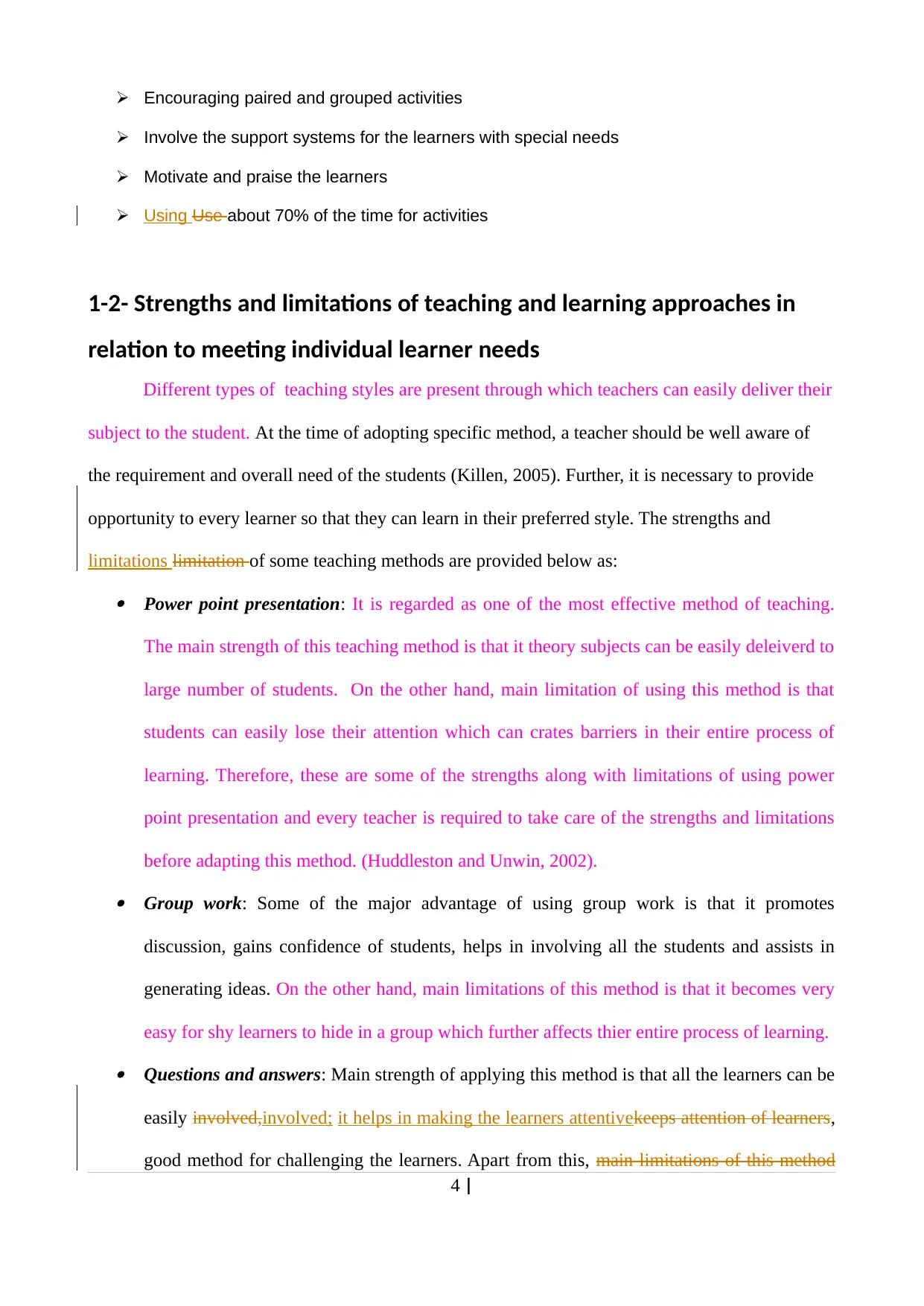
Encouraging paired and grouped activities
Involve the support systems for the learners with special needs
Motivate and praise the learners
Using Use about 70% of the time for activities
1-2- Strengths and limitations of teaching and learning approaches in
relation to meeting individual learner needs
Different types of teaching styles are present through which teachers can easily deliver their
subject to the student. At the time of adopting specific method, a teacher should be well aware of
the requirement and overall need of the students (Killen, 2005). Further, it is necessary to provide
opportunity to every learner so that they can learn in their preferred style. The strengths and
limitations limitation of some teaching methods are provided below as:
Power point presentation: It is regarded as one of the most effective method of teaching.
The main strength of this teaching method is that it theory subjects can be easily deleiverd to
large number of students. On the other hand, main limitation of using this method is that
students can easily lose their attention which can crates barriers in their entire process of
learning. Therefore, these are some of the strengths along with limitations of using power
point presentation and every teacher is required to take care of the strengths and limitations
before adapting this method. (Huddleston and Unwin, 2002).
Group work: Some of the major advantage of using group work is that it promotes
discussion, gains confidence of students, helps in involving all the students and assists in
generating ideas. On the other hand, main limitations of this method is that it becomes very
easy for shy learners to hide in a group which further affects thier entire process of learning.
Questions and answers: Main strength of applying this method is that all the learners can be
easily involved,involved; it helps in making the learners attentivekeeps attention of learners,
good method for challenging the learners. Apart from this, main limitations of this method
4 |
Involve the support systems for the learners with special needs
Motivate and praise the learners
Using Use about 70% of the time for activities
1-2- Strengths and limitations of teaching and learning approaches in
relation to meeting individual learner needs
Different types of teaching styles are present through which teachers can easily deliver their
subject to the student. At the time of adopting specific method, a teacher should be well aware of
the requirement and overall need of the students (Killen, 2005). Further, it is necessary to provide
opportunity to every learner so that they can learn in their preferred style. The strengths and
limitations limitation of some teaching methods are provided below as:
Power point presentation: It is regarded as one of the most effective method of teaching.
The main strength of this teaching method is that it theory subjects can be easily deleiverd to
large number of students. On the other hand, main limitation of using this method is that
students can easily lose their attention which can crates barriers in their entire process of
learning. Therefore, these are some of the strengths along with limitations of using power
point presentation and every teacher is required to take care of the strengths and limitations
before adapting this method. (Huddleston and Unwin, 2002).
Group work: Some of the major advantage of using group work is that it promotes
discussion, gains confidence of students, helps in involving all the students and assists in
generating ideas. On the other hand, main limitations of this method is that it becomes very
easy for shy learners to hide in a group which further affects thier entire process of learning.
Questions and answers: Main strength of applying this method is that all the learners can be
easily involved,involved; it helps in making the learners attentivekeeps attention of learners,
good method for challenging the learners. Apart from this, main limitations of this method
4 |
Paraphrase This Document
Need a fresh take? Get an instant paraphrase of this document with our AI Paraphraser
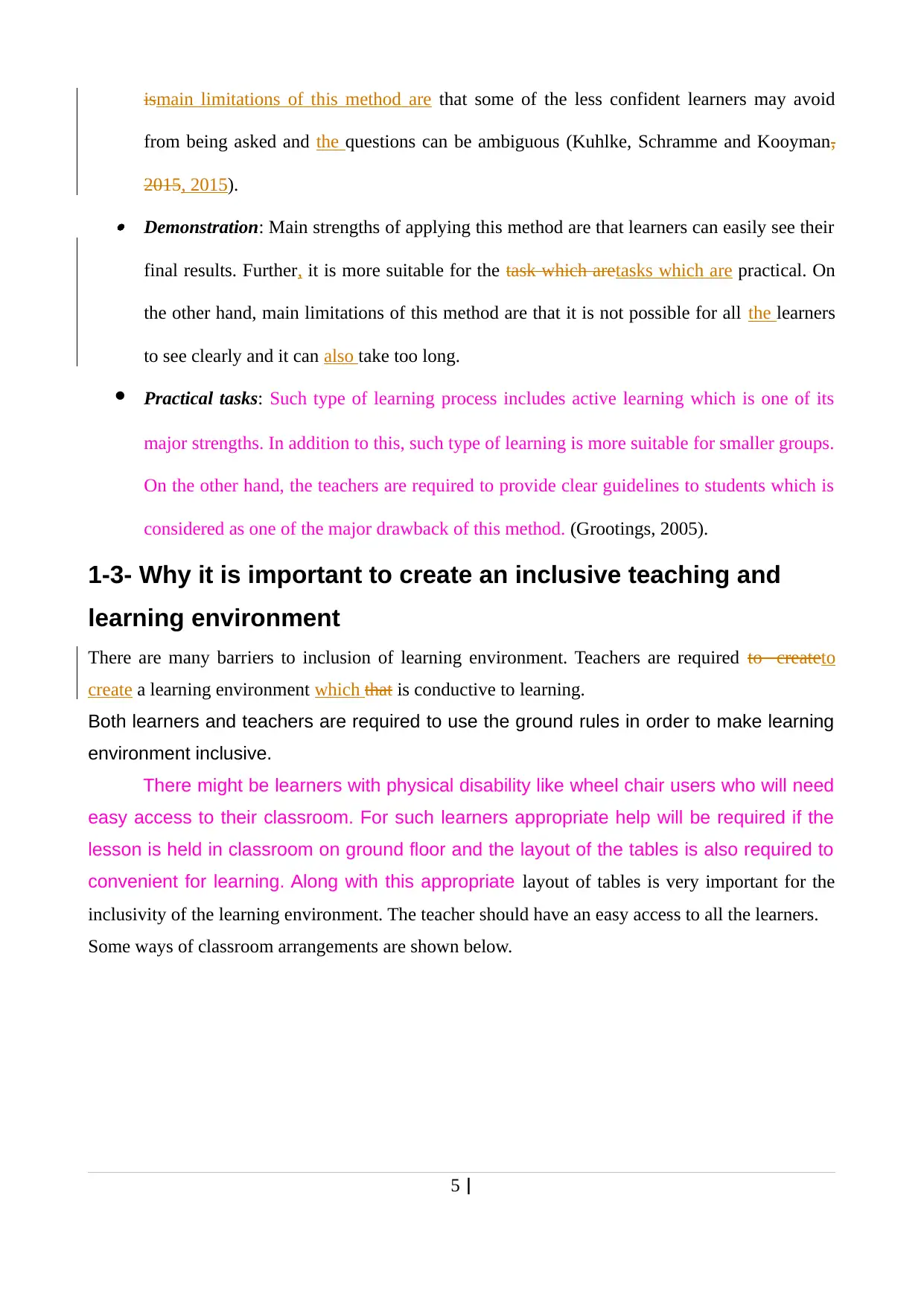
ismain limitations of this method are that some of the less confident learners may avoid
from being asked and the questions can be ambiguous (Kuhlke, Schramme and Kooyman,
2015, 2015).
Demonstration: Main strengths of applying this method are that learners can easily see their
final results. Further, it is more suitable for the task which aretasks which are practical. On
the other hand, main limitations of this method are that it is not possible for all the learners
to see clearly and it can also take too long.
Practical tasks: Such type of learning process includes active learning which is one of its
major strengths. In addition to this, such type of learning is more suitable for smaller groups.
On the other hand, the teachers are required to provide clear guidelines to students which is
considered as one of the major drawback of this method. (Grootings, 2005).
1-3- Why it is important to create an inclusive teaching and
learning environment
There are many barriers to inclusion of learning environment. Teachers are required to createto
create a learning environment which that is conductive to learning.
Both learners and teachers are required to use the ground rules in order to make learning
environment inclusive.
There might be learners with physical disability like wheel chair users who will need
easy access to their classroom. For such learners appropriate help will be required if the
lesson is held in classroom on ground floor and the layout of the tables is also required to
convenient for learning. Along with this appropriate layout of tables is very important for the
inclusivity of the learning environment. The teacher should have an easy access to all the learners.
Some ways of classroom arrangements are shown below.
5 |
from being asked and the questions can be ambiguous (Kuhlke, Schramme and Kooyman,
2015, 2015).
Demonstration: Main strengths of applying this method are that learners can easily see their
final results. Further, it is more suitable for the task which aretasks which are practical. On
the other hand, main limitations of this method are that it is not possible for all the learners
to see clearly and it can also take too long.
Practical tasks: Such type of learning process includes active learning which is one of its
major strengths. In addition to this, such type of learning is more suitable for smaller groups.
On the other hand, the teachers are required to provide clear guidelines to students which is
considered as one of the major drawback of this method. (Grootings, 2005).
1-3- Why it is important to create an inclusive teaching and
learning environment
There are many barriers to inclusion of learning environment. Teachers are required to createto
create a learning environment which that is conductive to learning.
Both learners and teachers are required to use the ground rules in order to make learning
environment inclusive.
There might be learners with physical disability like wheel chair users who will need
easy access to their classroom. For such learners appropriate help will be required if the
lesson is held in classroom on ground floor and the layout of the tables is also required to
convenient for learning. Along with this appropriate layout of tables is very important for the
inclusivity of the learning environment. The teacher should have an easy access to all the learners.
Some ways of classroom arrangements are shown below.
5 |
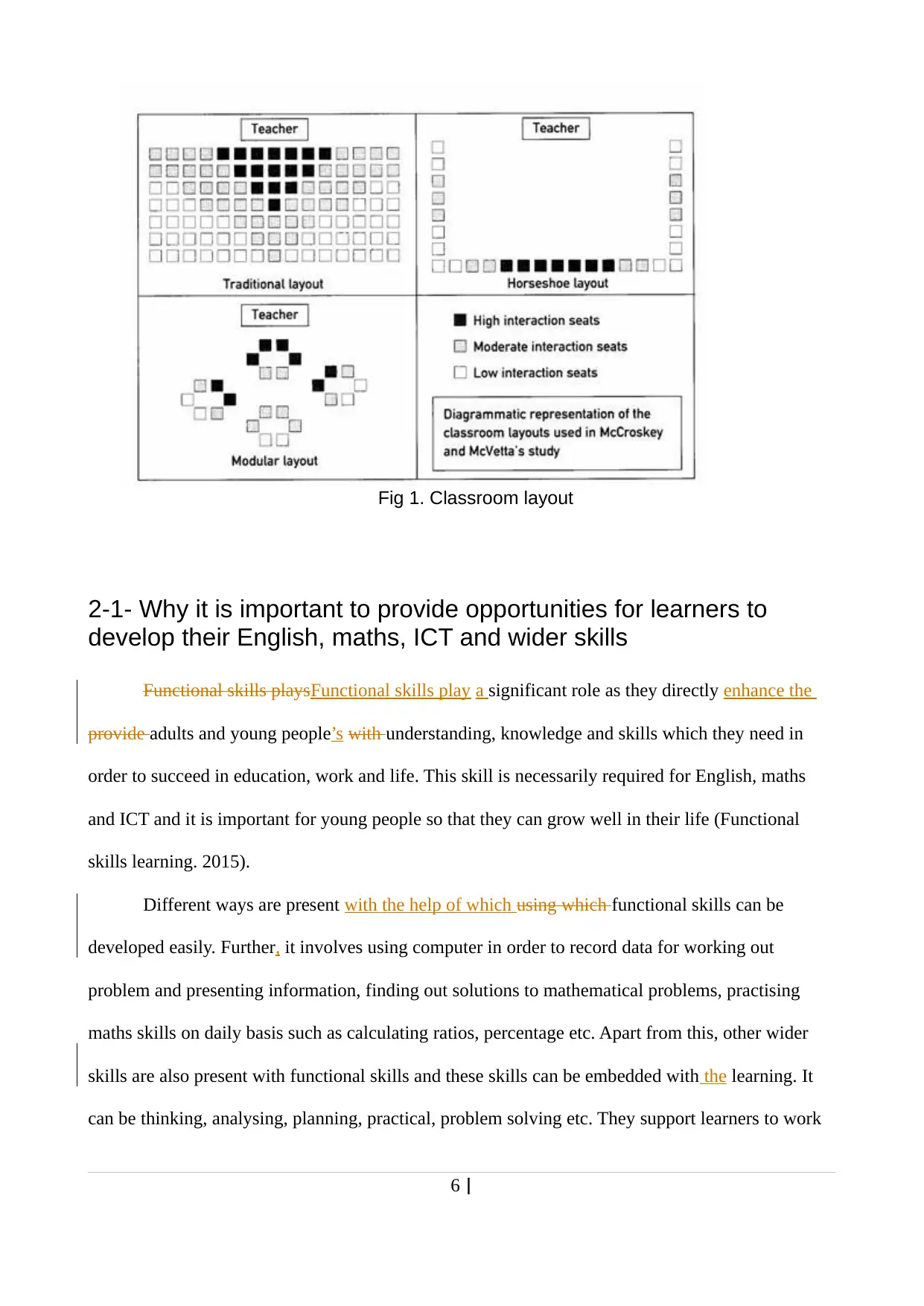
Fig 1. Classroom layout
2-1- Why it is important to provide opportunities for learners to
develop their English, maths, ICT and wider skills
Functional skills playsFunctional skills play a significant role as they directly enhance the
provide adults and young people’s with understanding, knowledge and skills which they need in
order to succeed in education, work and life. This skill is necessarily required for English, maths
and ICT and it is important for young people so that they can grow well in their life (Functional
skills learning. 2015).
Different ways are present with the help of which using which functional skills can be
developed easily. Further, it involves using computer in order to record data for working out
problem and presenting information, finding out solutions to mathematical problems, practising
maths skills on daily basis such as calculating ratios, percentage etc. Apart from this, other wider
skills are also present with functional skills and these skills can be embedded with the learning. It
can be thinking, analysing, planning, practical, problem solving etc. They support learners to work
6 |
2-1- Why it is important to provide opportunities for learners to
develop their English, maths, ICT and wider skills
Functional skills playsFunctional skills play a significant role as they directly enhance the
provide adults and young people’s with understanding, knowledge and skills which they need in
order to succeed in education, work and life. This skill is necessarily required for English, maths
and ICT and it is important for young people so that they can grow well in their life (Functional
skills learning. 2015).
Different ways are present with the help of which using which functional skills can be
developed easily. Further, it involves using computer in order to record data for working out
problem and presenting information, finding out solutions to mathematical problems, practising
maths skills on daily basis such as calculating ratios, percentage etc. Apart from this, other wider
skills are also present with functional skills and these skills can be embedded with the learning. It
can be thinking, analysing, planning, practical, problem solving etc. They support learners to work
6 |
⊘ This is a preview!⊘
Do you want full access?
Subscribe today to unlock all pages.

Trusted by 1+ million students worldwide
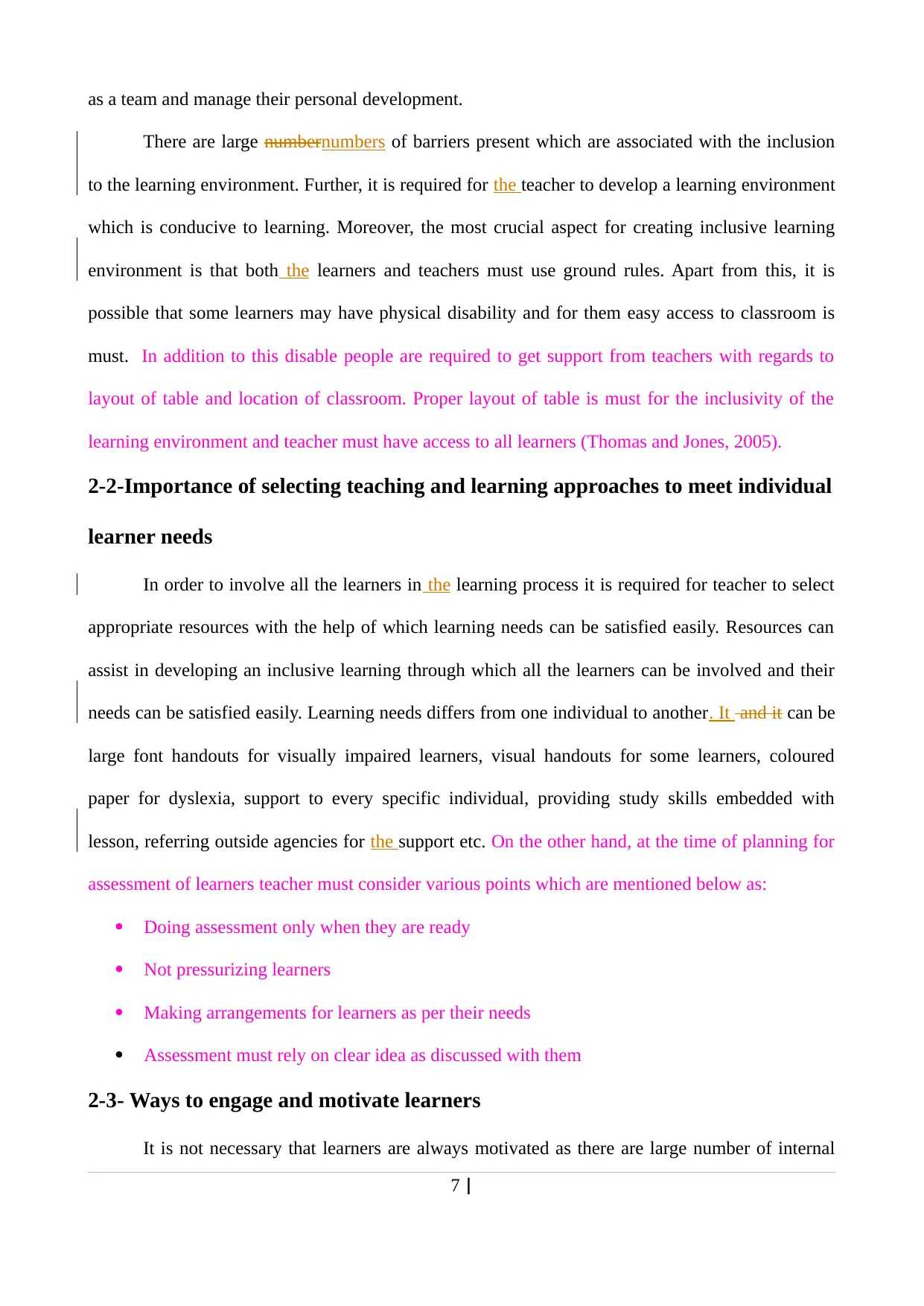
as a team and manage their personal development.
There are large numbernumbers of barriers present which are associated with the inclusion
to the learning environment. Further, it is required for the teacher to develop a learning environment
which is conducive to learning. Moreover, the most crucial aspect for creating inclusive learning
environment is that both the learners and teachers must use ground rules. Apart from this, it is
possible that some learners may have physical disability and for them easy access to classroom is
must. In addition to this disable people are required to get support from teachers with regards to
layout of table and location of classroom. Proper layout of table is must for the inclusivity of the
learning environment and teacher must have access to all learners (Thomas and Jones, 2005).
2-2-Importance of selecting teaching and learning approaches to meet individual
learner needs
In order to involve all the learners in the learning process it is required for teacher to select
appropriate resources with the help of which learning needs can be satisfied easily. Resources can
assist in developing an inclusive learning through which all the learners can be involved and their
needs can be satisfied easily. Learning needs differs from one individual to another. It and it can be
large font handouts for visually impaired learners, visual handouts for some learners, coloured
paper for dyslexia, support to every specific individual, providing study skills embedded with
lesson, referring outside agencies for the support etc. On the other hand, at the time of planning for
assessment of learners teacher must consider various points which are mentioned below as:
Doing assessment only when they are ready
Not pressurizing learners
Making arrangements for learners as per their needs
Assessment must rely on clear idea as discussed with them
2-3- Ways to engage and motivate learners
It is not necessary that learners are always motivated as there are large number of internal
7 |
There are large numbernumbers of barriers present which are associated with the inclusion
to the learning environment. Further, it is required for the teacher to develop a learning environment
which is conducive to learning. Moreover, the most crucial aspect for creating inclusive learning
environment is that both the learners and teachers must use ground rules. Apart from this, it is
possible that some learners may have physical disability and for them easy access to classroom is
must. In addition to this disable people are required to get support from teachers with regards to
layout of table and location of classroom. Proper layout of table is must for the inclusivity of the
learning environment and teacher must have access to all learners (Thomas and Jones, 2005).
2-2-Importance of selecting teaching and learning approaches to meet individual
learner needs
In order to involve all the learners in the learning process it is required for teacher to select
appropriate resources with the help of which learning needs can be satisfied easily. Resources can
assist in developing an inclusive learning through which all the learners can be involved and their
needs can be satisfied easily. Learning needs differs from one individual to another. It and it can be
large font handouts for visually impaired learners, visual handouts for some learners, coloured
paper for dyslexia, support to every specific individual, providing study skills embedded with
lesson, referring outside agencies for the support etc. On the other hand, at the time of planning for
assessment of learners teacher must consider various points which are mentioned below as:
Doing assessment only when they are ready
Not pressurizing learners
Making arrangements for learners as per their needs
Assessment must rely on clear idea as discussed with them
2-3- Ways to engage and motivate learners
It is not necessary that learners are always motivated as there are large number of internal
7 |
Paraphrase This Document
Need a fresh take? Get an instant paraphrase of this document with our AI Paraphraser
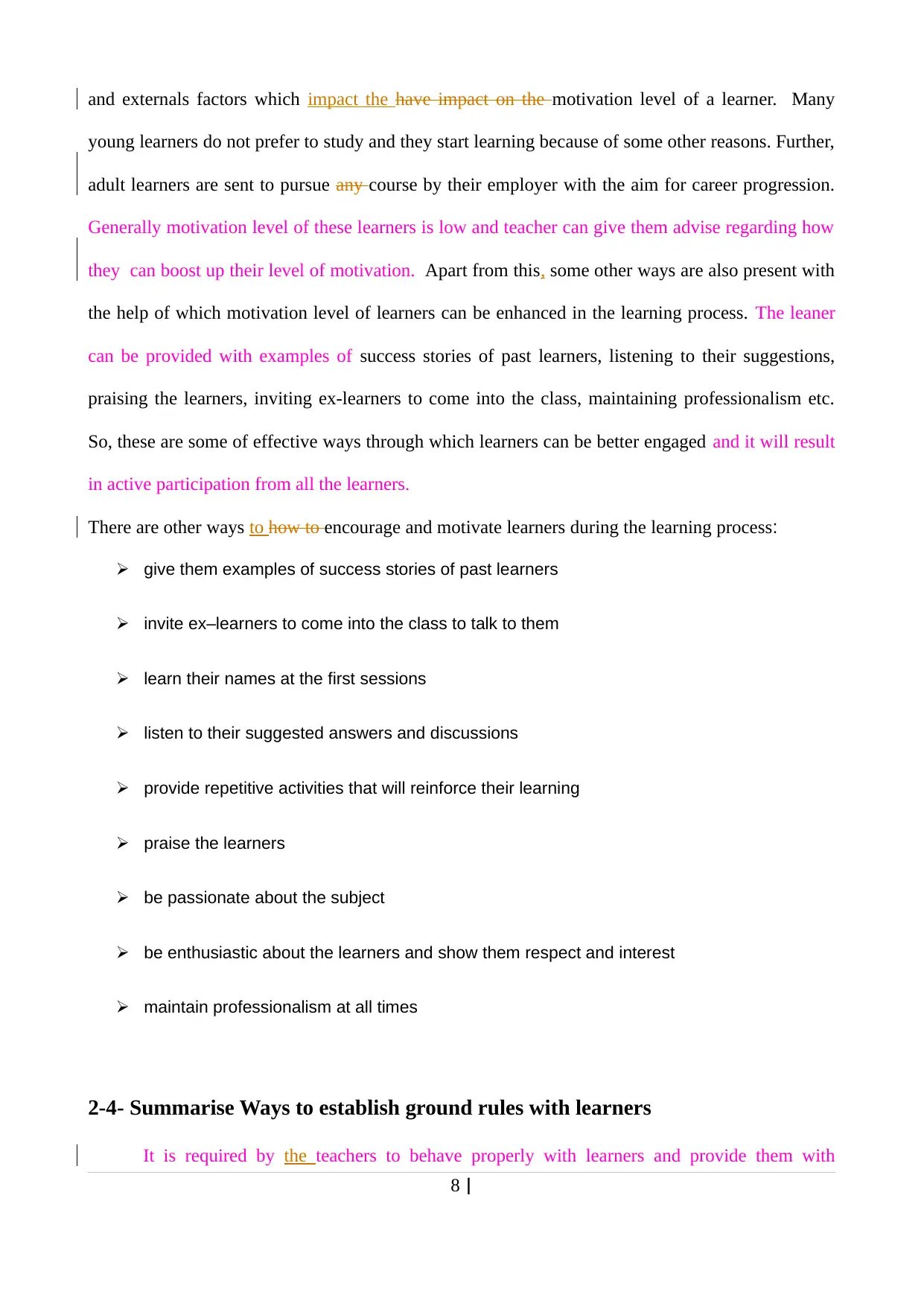
and externals factors which impact the have impact on the motivation level of a learner. Many
young learners do not prefer to study and they start learning because of some other reasons. Further,
adult learners are sent to pursue any course by their employer with the aim for career progression.
Generally motivation level of these learners is low and teacher can give them advise regarding how
they can boost up their level of motivation. Apart from this, some other ways are also present with
the help of which motivation level of learners can be enhanced in the learning process. The leaner
can be provided with examples of success stories of past learners, listening to their suggestions,
praising the learners, inviting ex-learners to come into the class, maintaining professionalism etc.
So, these are some of effective ways through which learners can be better engaged and it will result
in active participation from all the learners.
There are other ways to how to encourage and motivate learners during the learning process:
give them examples of success stories of past learners
invite ex–learners to come into the class to talk to them
learn their names at the first sessions
listen to their suggested answers and discussions
provide repetitive activities that will reinforce their learning
praise the learners
be passionate about the subject
be enthusiastic about the learners and show them respect and interest
maintain professionalism at all times
2-4- Summarise Ways to establish ground rules with learners
It is required by the teachers to behave properly with learners and provide them with
8 |
young learners do not prefer to study and they start learning because of some other reasons. Further,
adult learners are sent to pursue any course by their employer with the aim for career progression.
Generally motivation level of these learners is low and teacher can give them advise regarding how
they can boost up their level of motivation. Apart from this, some other ways are also present with
the help of which motivation level of learners can be enhanced in the learning process. The leaner
can be provided with examples of success stories of past learners, listening to their suggestions,
praising the learners, inviting ex-learners to come into the class, maintaining professionalism etc.
So, these are some of effective ways through which learners can be better engaged and it will result
in active participation from all the learners.
There are other ways to how to encourage and motivate learners during the learning process:
give them examples of success stories of past learners
invite ex–learners to come into the class to talk to them
learn their names at the first sessions
listen to their suggested answers and discussions
provide repetitive activities that will reinforce their learning
praise the learners
be passionate about the subject
be enthusiastic about the learners and show them respect and interest
maintain professionalism at all times
2-4- Summarise Ways to establish ground rules with learners
It is required by the teachers to behave properly with learners and provide them with
8 |
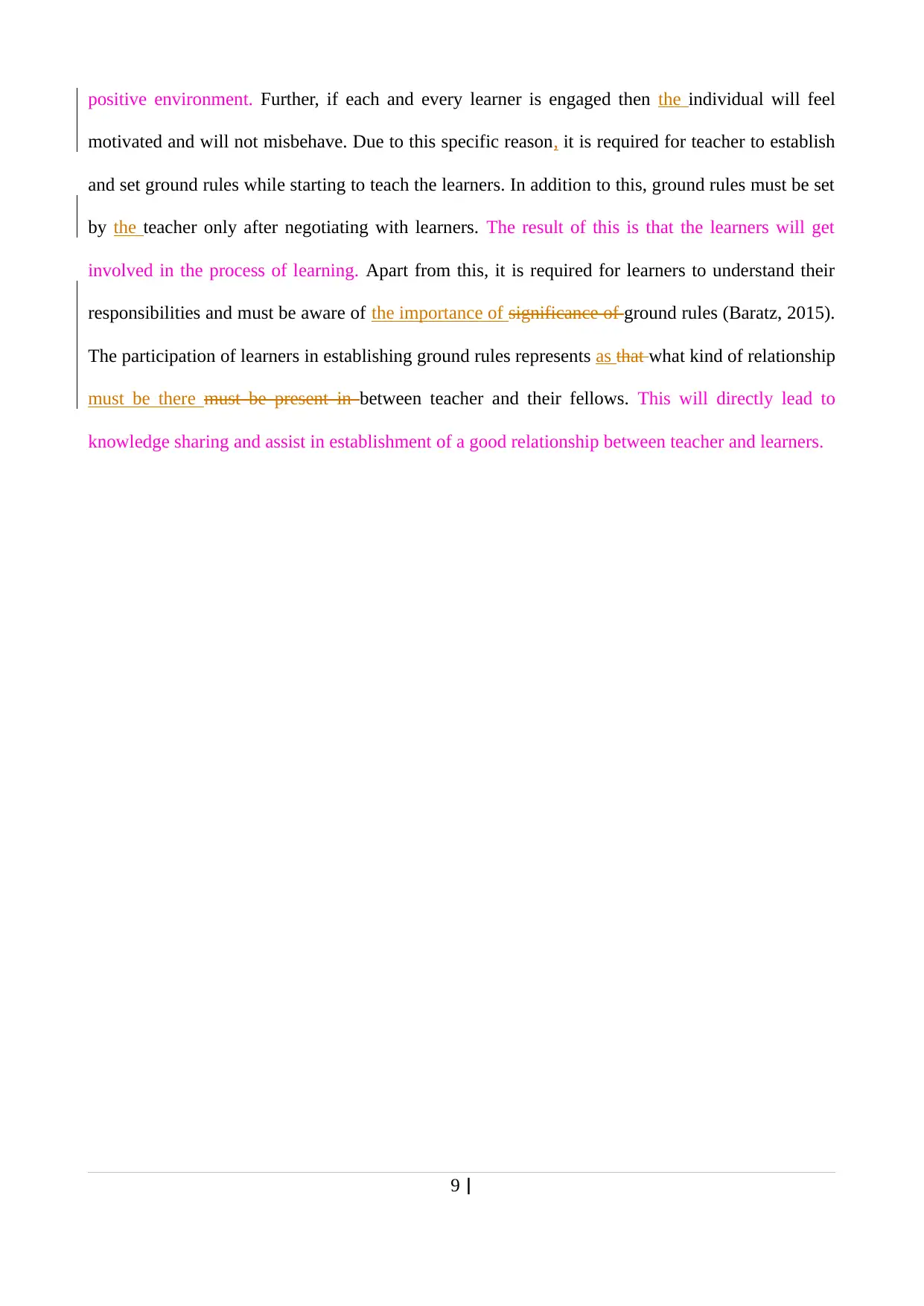
positive environment. Further, if each and every learner is engaged then the individual will feel
motivated and will not misbehave. Due to this specific reason, it is required for teacher to establish
and set ground rules while starting to teach the learners. In addition to this, ground rules must be set
by the teacher only after negotiating with learners. The result of this is that the learners will get
involved in the process of learning. Apart from this, it is required for learners to understand their
responsibilities and must be aware of the importance of significance of ground rules (Baratz, 2015).
The participation of learners in establishing ground rules represents as that what kind of relationship
must be there must be present in between teacher and their fellows. This will directly lead to
knowledge sharing and assist in establishment of a good relationship between teacher and learners.
9 |
motivated and will not misbehave. Due to this specific reason, it is required for teacher to establish
and set ground rules while starting to teach the learners. In addition to this, ground rules must be set
by the teacher only after negotiating with learners. The result of this is that the learners will get
involved in the process of learning. Apart from this, it is required for learners to understand their
responsibilities and must be aware of the importance of significance of ground rules (Baratz, 2015).
The participation of learners in establishing ground rules represents as that what kind of relationship
must be there must be present in between teacher and their fellows. This will directly lead to
knowledge sharing and assist in establishment of a good relationship between teacher and learners.
9 |
⊘ This is a preview!⊘
Do you want full access?
Subscribe today to unlock all pages.

Trusted by 1+ million students worldwide
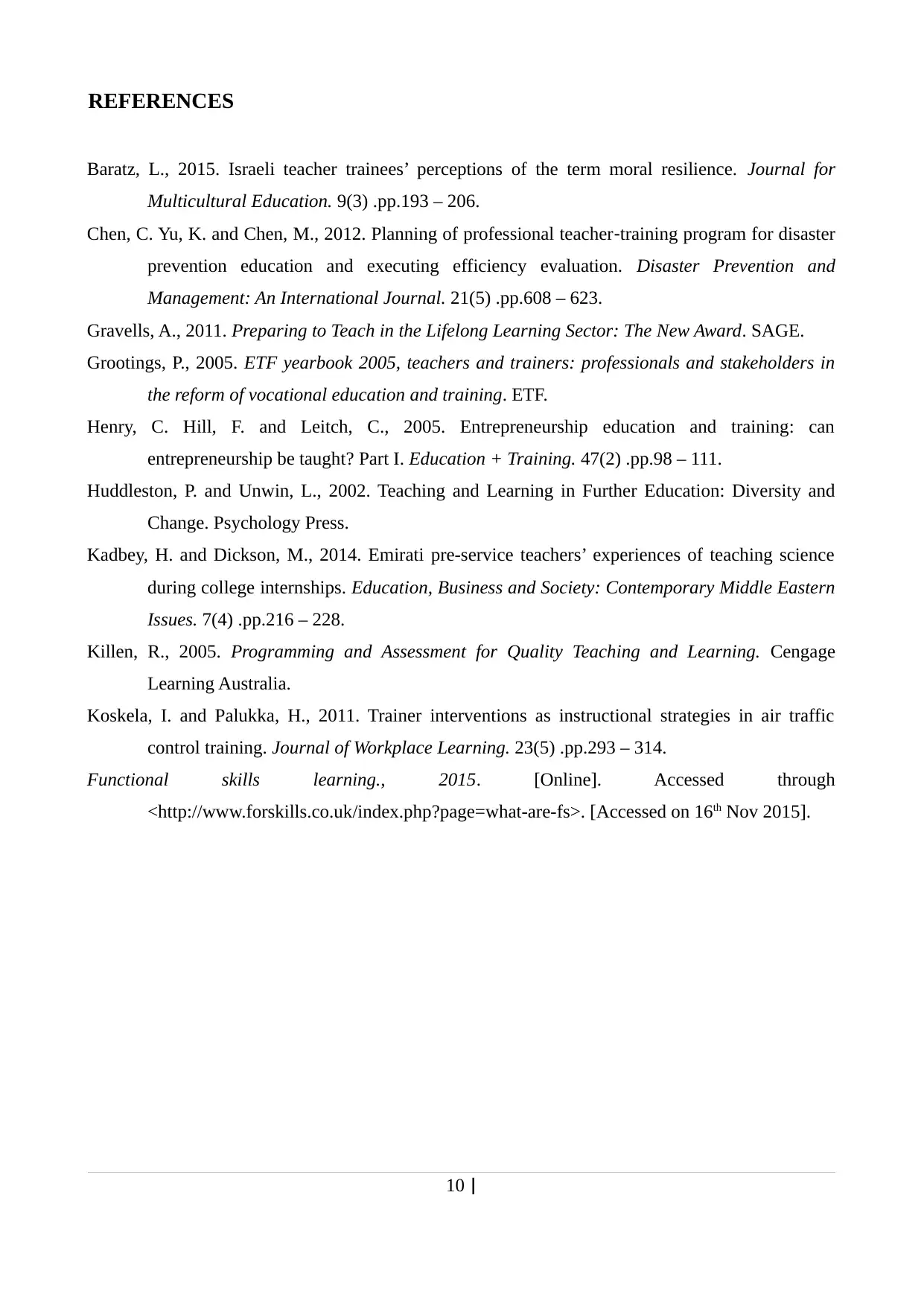
REFERENCES
Baratz, L., 2015. Israeli teacher trainees’ perceptions of the term moral resilience. Journal for
Multicultural Education. 9(3) .pp.193 – 206.
Chen, C. Yu, K. and Chen, M., 2012. Planning of professional teacher‐training program for disaster
prevention education and executing efficiency evaluation. Disaster Prevention and
Management: An International Journal. 21(5) .pp.608 – 623.
Gravells, A., 2011. Preparing to Teach in the Lifelong Learning Sector: The New Award. SAGE.
Grootings, P., 2005. ETF yearbook 2005, teachers and trainers: professionals and stakeholders in
the reform of vocational education and training. ETF.
Henry, C. Hill, F. and Leitch, C., 2005. Entrepreneurship education and training: can
entrepreneurship be taught? Part I. Education + Training. 47(2) .pp.98 – 111.
Huddleston, P. and Unwin, L., 2002. Teaching and Learning in Further Education: Diversity and
Change. Psychology Press.
Kadbey, H. and Dickson, M., 2014. Emirati pre-service teachers’ experiences of teaching science
during college internships. Education, Business and Society: Contemporary Middle Eastern
Issues. 7(4) .pp.216 – 228.
Killen, R., 2005. Programming and Assessment for Quality Teaching and Learning. Cengage
Learning Australia.
Koskela, I. and Palukka, H., 2011. Trainer interventions as instructional strategies in air traffic
control training. Journal of Workplace Learning. 23(5) .pp.293 – 314.
Functional skills learning., 2015. [Online]. Accessed through
<http://www.forskills.co.uk/index.php?page=what-are-fs>. [Accessed on 16th Nov 2015].
10 |
Baratz, L., 2015. Israeli teacher trainees’ perceptions of the term moral resilience. Journal for
Multicultural Education. 9(3) .pp.193 – 206.
Chen, C. Yu, K. and Chen, M., 2012. Planning of professional teacher‐training program for disaster
prevention education and executing efficiency evaluation. Disaster Prevention and
Management: An International Journal. 21(5) .pp.608 – 623.
Gravells, A., 2011. Preparing to Teach in the Lifelong Learning Sector: The New Award. SAGE.
Grootings, P., 2005. ETF yearbook 2005, teachers and trainers: professionals and stakeholders in
the reform of vocational education and training. ETF.
Henry, C. Hill, F. and Leitch, C., 2005. Entrepreneurship education and training: can
entrepreneurship be taught? Part I. Education + Training. 47(2) .pp.98 – 111.
Huddleston, P. and Unwin, L., 2002. Teaching and Learning in Further Education: Diversity and
Change. Psychology Press.
Kadbey, H. and Dickson, M., 2014. Emirati pre-service teachers’ experiences of teaching science
during college internships. Education, Business and Society: Contemporary Middle Eastern
Issues. 7(4) .pp.216 – 228.
Killen, R., 2005. Programming and Assessment for Quality Teaching and Learning. Cengage
Learning Australia.
Koskela, I. and Palukka, H., 2011. Trainer interventions as instructional strategies in air traffic
control training. Journal of Workplace Learning. 23(5) .pp.293 – 314.
Functional skills learning., 2015. [Online]. Accessed through
<http://www.forskills.co.uk/index.php?page=what-are-fs>. [Accessed on 16th Nov 2015].
10 |
1 out of 10
Related Documents
Your All-in-One AI-Powered Toolkit for Academic Success.
+13062052269
info@desklib.com
Available 24*7 on WhatsApp / Email
![[object Object]](/_next/static/media/star-bottom.7253800d.svg)
Unlock your academic potential
Copyright © 2020–2025 A2Z Services. All Rights Reserved. Developed and managed by ZUCOL.




